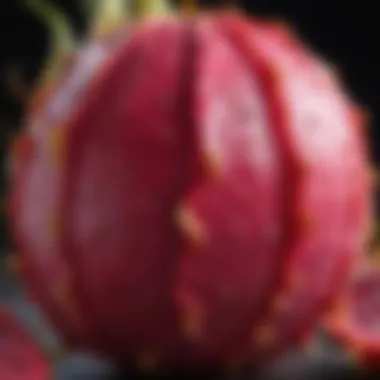Mastering Dragon Fruit: Peeling and Culinary Uses


Intro
Dragon fruit, often called pitaya, has caught the eye of many food enthusiasts in recent years. Its vibrant pink skin and unique green scales might make it look like something from a sci-fi movie, but it’s so much more than just a pretty face. This tropical fruit is loaded with nutrients and has a flavor that's mildly sweet, making it a fantastic addition to various dishes. However, peeling this exotic fruit can be a bit daunting for many people.
Peeling dragon fruit not only unlocks its vibrant interior but also brings out its potential in the kitchen. In this comprehensive guide, we’ll delve into the anatomy of the dragon fruit, break down the necessary tools for peeling it effectively, and provide step-by-step instructions to make the process as smooth as a ripe banana. Whether you're standing in your kitchen for the first time or you're a seasoned chef, this guide offers something for everyone. Understanding how to peel dragon fruit can elevate your culinary skills and add a splash of color to your meals.
Now, let's dive into the essentials by breaking down what you'll need before you make your first slice.
Prelude to Dragon Fruit
Dragon fruit, also known as pitaya, has been grabbing attention in both culinary and health circles. Its vibrant colors and unique texture make it not just an appealing fruit for the eyes but also a delightful treat for the palate. The increasing popularity of this exotic fruit comes from its extraordinary versatility and an array of health benefits. Understanding dragon fruit is not just academic; it lays the groundwork for appreciating its full potential in the kitchen.
Origins and Varieties
Dragon fruit hails primarily from Central America, but it is cultivated in various regions such as Southeast Asia, Mexico, and Israel. It's intriguing how this fruit, with its whimsical appearance, emerged from a cactus known as Hylocereus. The most common varieties include the red-skinned with white flesh and the less common yellow-skinned variety. Each variety has its own distinctive flavor profile. The bright pink or red skin adorned with green scales evokes images of mythical creatures, which is possibly how the fruit earned the name "dragon fruit."
- Hylocereus undatus: Often called white-fleshed dragon fruit, this type is the most widely available and has a mildly sweet flavor.
- Hylocereus costaricensis: Renowned for its red flesh and vibrant pink skin, it packs a more intense flavor that stands out in fruit salads and smoothies.
- Hylocereus megalanthus: This yellow-skinned variety is known for its sweetness, considered by many to be the tastiest of the three.
Nutritional Profile
When it comes to health, dragon fruit doesn't skimp on nutrients. It's low in calories yet packed with vitamins and minerals. A single serving is a great source of vitamin C, fiber, and healthy fats. Its antioxidant properties come from substances like betalains and vitamin C, which help combat oxidative stress in the body.
- Fiber: Aids digestion and can help in weight management by promoting a feeling of fullness.
- Vitamins A and C: Vital for skin health and immune function.
- Magnesium: Beneficial for muscle function and energy production.
"Dragon fruit’s nutritional profile is full of antioxidants, fiber, and vitamins; it is truly a powerhouse for health-conscious consumers."
Given all this, one might wonder why dragon fruit isn’t more commonly integrated into everyday diets. Perhaps it’s the peeling that deters people, but that’s where this guide comes in. By exploring how to properly peel and prepare dragon fruit, individuals can be encouraged to embrace this beautiful fruit, leading to a more colorful plate and healthier lifestyle.
Understanding the Structure of Dragon Fruit
When it comes to peeling dragon fruit, one might think it’s just a simple task of removing the skin. However, to truly appreciate this unique fruit, it’s essential to understand its structure. The structure not only influences the peeling process but also contributes significantly to the overall eating experience. Knowing the ins and outs of this fruit helps achieve the right balance between enjoying its nutrition and aesthetics.
External Features
The external appearance of dragon fruit is nothing less than striking. Often described as vibrant, its skin is typically a bright pink, yellow, or red, adorned with green, scale-like leaves. This edgy look serves more than just a decorative purpose; it plays a role in protecting the flesh inside. The scales, or bracts, are not just for show; they help shield the fruit from pests and extreme weather conditions.
One of the critical features to note is the firmness of the skin, which varies among different varieties. For instance, the Hylocereus varieties have a thicker, more textured exterior compared to the smoother surface of Selenicereus. This hardness can impact how easily one can peel the fruit. Another important aspect? The color might hint at its ripeness. Generally, a bright color suggests optimal ripeness, while duller tones might mean the fruit is past its peak.
Internal Composition
Once the outer skin is removed, the real treasure is revealed—the internal composition of dragon fruit. The flesh itself can appear in shades of white or deep magenta, dotted with tiny black seeds, which are edible and contribute to the fruit's delightful crunch.
These seeds are actually quite significant—they’re packed with protein and healthy fats, making dragon fruit beneficial not just for its taste, but also for its nutritional profile. Furthermore, the flesh’s mildly sweet flavor carries hints of kiwi and pear, which is why it’s beloved in various culinary creations.
The interior is not only about taste and nutrition; it also tells a story of how to handle dragon fruit effectively. Knowing how firm or soft it is aids in determining the best peeling method. A slightly squishy fruit means easy peeling, while a firmer one may need a bit of finesse. This means the keen cook should be attentive, adjusting their technique based on the fruit's readiness.
In short, grasping both external and internal aspects of dragon fruit lays a strong foundation for proper peeling techniques. It is about more than skin deep; each feature plays a role that not only enhances the flavor but also contributes to an enjoyable culinary experience.
"Understanding the fruit's structure elevates the peeling experience from a chore to an art form."
Venture beyond merely peeling; dive into the essence of dragon fruit, ensuring that each bite is a delight.
Essential Tools for Peeling
When it comes to peeling dragon fruit, having the right tools at your disposal is crucial. The process can be as tricky as balancing a spoon on your nose, but with the appropriate implements, it can become a breeze. The correct utensils not only simplify the peeling process but also help to maintain the fruit's integrity, ensuring you're left with the maximum yield of delicious flesh. Let's break down what you'll need to tackle this vibrant fruit with confidence.
Required Utensils
To navigate the art of peeling dragon fruit, a few key utensils will help you get the job done efficiently:


- Chef's Knife: A good-quality knife is essential for slicing through the thick skin of the dragon fruit. A blade that’s sharp and sturdy allows for clean cuts, minimizing waste and ensuring you leave as much flesh intact as possible.
- Cutting Board: A stable surface is vital for safe and effective peeling. A cutting board provides a non-slip area to work, preventing unintended slip-ups that could lead to accidents.
- Spoon: Once you’ve made the initial cuts, a spoon comes in handy to scoop out the flesh. The curvature of a spoon fits perfectly against the fruit’s wall, making this task easier while avoiding any unnecessarily rough handling.
- Vegetable Peeler (optional): If you find yourself with a dragon fruit whose skin is stubborn, a vegetable peeler can help remove the tough outer layer effectively. Sometimes, the simplest utensils do the trick.
The right utensils set the stage for a successful peeling venture, allowing you to focus more on enjoying the fruit than battling with it.
Safety Precautions
Peeling dragon fruit can be an engaging and rewarding experience, but caution should always be your companion in the kitchen. Here are some important safety measures to keep in mind:
- Proper Grip: While peeling, ensure that your grip on the knife is firm and controlled. This prevents slips that could lead to cuts. Your fingers should be kept away from the blade, allowing only the fruit to be within harm's way.
- Stabilize the Fruit: Keep the dragon fruit steady while slicing. If it rolls around, it’s like trying to peel a greased watermelon; you’re just setting yourself up for trouble. Employ a cutting board with a slip-resistant base or a damp cloth underneath to keep it stable.
- Slice Away From Yourself: This is a golden rule in any kind of knife work. Always cut away from your body. It sounds simple, but it's easy to forget in the heat of the moment.
- Be Mindful of the Skin: The outer skin of the dragon fruit is quite thick and can sometimes have tough bits. Make sure to slice through it with purpose but care, avoiding any unnecessary force that could lead to an accidental nick.
By taking your time and being mindful of the tools you use, peeling dragon fruit can transform from a daunting task into a simple, straightforward procedure.
By keeping these tools and precautions in mind, you're setting yourself up for success in mastering the peeling technique, while also ensuring a safe and enjoyable experience.
Step-by-Step Guide to Peeling Dragon Fruit
Peeling dragon fruit isn't just a culinary task; it's a gateway to experiencing its luxurious texture and vibrant colors. This section lays down the cornerstone of the guide, as mastering the peeling process enhances both presentation and flavor experiences. Often thought of simply as an exotic fruit, dragon fruit offers numerous health advantages and is a fantastic addition to various dishes. Hence, understanding how to peel it correctly allows both novice and seasoned cooks to utilize its full potential.
Selecting the Right Fruit
Choosing a ripe dragon fruit is crucial for achieving the best flavor. A dragon fruit that's too underripe can be hard and flavorless, while an overripe one might taste bland or mushy. To find the right fruit, look for a vibrant color, typically bright pink or yellow skin, depending on the variety. The fruit should feel slightly soft to the touch but not squishy. A fruit that has bright green scales indicates it may need more time to ripen. Furthermore, checking for any dark spots or blemishes is essential; those could indicate spoilage. Here’s a quick rundown of what to look for:
- Color: Brightness matters; avoid dull skin
- Texture: Slightly soft but not mushy
- Scales: Green tips should be minimal
- Blemishes: Watch out for dark spots
Preparation Process
Taking the time to prepare before peeling makes the actual peeling process smoother. First things first, remove the dragon fruit from any packaging and give it a good wash under running water to eliminate any dirt or pesticide residue. After drying it with a clean towel, place the fruit on a cutting board. Using a sharp knife is vital to avoid struggling with the skin. Cut the fruit in half, which offers a straightforward view of the fleshy interior — a vibrant white or reddish-purple with tiny black seeds. This helps you understand how much of the skin you might want to remove while preserving as much flesh as possible. Always keep safety in mind while handling the knife. Here’s a simple preparation checklist:
- Wash the fruit thoroughly
- Dry with a clean towel
- Position on a stable cutting board
- Use a sharp knife for cutting
Peeling Techniques
Now comes the moment of truth: peeling the fruit. There are a couple of techniques here, so let’s break it down. One effective method is to slice off the ends of the dragon fruit before making vertical cuts down its shape, allowing you to gently peel off the skin without wasting any flesh. An alternative approach is to use a spoon. As odd as it may sound, you can scoop out the flesh gently after cutting it in half. This method is often cleaner and less likely to lead to mishaps with the knife.
Here’s how to execute the peeling:
- For Knife Method: After cutting the ends off, make vertical cuts along the sides and slowly peel back the skin.
- For Spoon Method: Simply scoop the flesh from the skin, which reduces mess and gives you the flesh in one piece.
Both techniques yield beautiful results. Whatever method you choose, be mindful of your movements. Slow and steady wins the race when it comes to peeling dragon fruit, as rushing may lead to unnecessary waste.
"Peeling isn’t merely removing a skin; it’s the first step towards appreciating dragon fruit’s delightful nuances."
Common Mistakes to Avoid
When diving into the world of dragon fruit, whether for the first time or you’ve done it a few times before, it’s easy to slip up and make mistakes that can compromise the quality of your experience. Understanding common pitfalls is crucial in maximizing the flavor and presentation of this tropical delight. Let’s dig into a couple of key missteps that can occur during the peeling process and explore how to steer clear of them for optimal enjoyment.
Over-Peeling
One of the most notable blunders when peeling dragon fruit is over-peeling. This mistake not only leads to wasted fruit but also diminishes the overall taste experience. The outer skin of the dragon fruit possesses vibrant colors and a unique texture, which many people disregard. This skin has no negative effect on the fruit's flavor and is often discarded unnecessarily.
"One may think that removing the outer layer completely will enhance purity, but in reality, it strips away the vibrant character of this exotic fruit."
To avoid over-peeling, start by making shallow cuts into the flesh while being mindful of the distance to the skin. The goal is to remove just enough of the outer layer without being too aggressive. When properly executed, you can utilize the bright colors and unique textures for presentation in any dish. This approach not only elevates your culinary presentation but also helps in appreciating the unique characteristics that dragon fruit offers.
Ignoring Ripeness
Another common mistake that can occur when handling dragon fruit is ignoring its ripeness. A fruit that’s under ripe will have a more bland taste, while overripe dragon fruit can turn mushy and unappealing. Recognizing the right time to peel and consume dragon fruit can significantly affect the taste and enjoyment.
So how can you tell if your dragon fruit is ready? Here are some signs:
- Color: A ripe dragon fruit typically has a vibrant pink or yellow skin. Dull or faded colors can indicate under ripeness.
- Texture: Gently squeeze the fruit. It should yield slightly to pressure, similar to a ripe avocado.
- Horn Tips: The green tips of the scales should be a little withered. If they are too sharp and sturdy, it’s likely the fruit is not yet ripe.


By paying close attention to these indicators, you can ensure that you are enjoying dragon fruit at its best. Ignoring ripeness not only leads to disappointment but can also hinder your potential to create amazing culinary additions.
When peeling this exotic fruit, keep these common mistakes at the forefront of your mind. By focusing on not over-peeling and ensuring that you're working with ripe fruit, you’ll be well on your way to mastering not only the art of peeling but engaging fully in the wonderful experience that dragon fruit has to offer.
Culinary Uses for Dragon Fruit
Dragon fruit, with its vibrant color and unique texture, serves as more than just a pretty centerpiece on a plate. This exotic fruit brings a multitude of culinary possibilities to the table, making it a sought-after ingredient across various cuisines. Understanding its uses not only enhances our appreciation for dragon fruit but also broadens our culinary repertoire.
In culinary applications, dragon fruit introduces a refreshing crunch and a subtle sweetness, making it a versatile ingredient that can elevate both simple and elaborate dishes. Here, we explore several ways to incorporate dragon fruit into meals, focusing on its adaptability in salads, beverages, and desserts.
In Salads and Salsas
Dragon fruit can effortlessly bring a burst of color and flavor to salads and salsas. Its mildly sweet taste contrasts beautifully with savory ingredients, creating a delightful balance. The texture is slightly crunchy, which adds a refreshing element to every bite. For example, mixing dragon fruit with arugula, cherry tomatoes, and avocado, creates a salad that not only looks stunning but also tantalizes the taste buds.
Moreover, when making salsas, combining diced dragon fruit with mango, red onion, cilantro, and lime results in a vibrant dish perfect for tacos or grilled seafood. The addition of dragon fruit not only enhances the dish visually but also contributes a nutrient-packed element.
"Dragon fruit's charm lies in its ability to complement a myriad of flavors, from zesty limes to creamy avocados."
In Smoothies and Juices
In the realm of beverages, dragon fruit shines bright. Its striking magenta hue and subtle sweetness make it a fantastic choice for smoothies and juices. Blending dragon fruit with bananas and spinach not only offers a visually appealing drink but also creates a smooth texture, making it palatable for kids and adults alike.
Dragon fruit juice on its own is refreshing, often enjoyed after a workout or during hot summer days. For an added twist, mixing it with coconut water or pineapple juice can transport you straight to an oasis. The natural antioxidants present in dragon fruit also promote health, providing another reason to indulge in these delicious drinks.
In Desserts
When it comes to desserts, dragon fruit is nothing short of a showstopper. Its unique texture lends itself well to various sweet preparations. Consider creating a dragon fruit sorbet by pureeing the flesh, mixing it with a bit of sugar and lime juice before freezing. This simple yet delightful dessert encapsulates summertime flavors and refreshes the palate.
Additionally, dragon fruit can be used in parfaits layered with yogurt and granola, offering both taste and nutrition in one dish. Try incorporating the fruit into cakes or tarts, where its striking color can create a visually stunning centerpiece.
The sweetness of dragon fruit also pairs well with coconut or vanilla-based desserts, adding a tropical twist.
Regardless of how you choose to use dragon fruit, its unique qualities and flavors can enhance any meal or snack, making it a worthy addition to your kitchen. The possibilities are genuinely endless, limited only by your imagination!
Storage and Preservation
Storing dragon fruit correctly is crucial not only for maintaining its fresh, vibrant feel but also for ensuring the best taste and nutritional value. With its striking appearance, dragon fruit often catches the eye in grocery stores and markets. However, without proper storage methods, this delicate fruit can quickly lose its appeal, turning from delightful to displeasing.
Short-term Storage
When it comes to short-term storage, the goal is simplicity. If you plan to consume the dragon fruit within a few days, simply placing it in the refrigerator is your best bet. Wrap it in a paper towel to absorb any moisture and prevent bruising. A key point to remember is to keep it away from other fruits; dragon fruit emits ethylene gas, which can accelerate ripening in its neighbors, especially delicate fruits like bananas or mangoes.
- Optimal Temperature: Aim for a cool spot in your fridge, around 45°F to 50°F (7°C to 10°C).
- Shelf Life: A fresh dragon fruit can last up to five to seven days when refrigerated.
Always check for firmness; if it begins to feel overly soft, it’s best to eat it sooner rather than later. This is a fruit that does not wait around for indecision.
Long-term Preservation Methods
If you're looking at a longer horizon, preserving dragon fruit can be slightly trickier but very achievable. Here are some time-tested methods to keep your dragon fruit fresh and flavorful for an extended period:
- Freezing:
- Dehydrating:
- Canning:
- Preparation: Cut the fruit into cubes or slices.
- Packaging: Place pieces in an airtight container or freezer bag, ensuring all air is removed.
- Usage: When you're ready to enjoy, simply thaw in the fridge or toss directly into a smoothie.
- Equipment Needed: A food dehydrator can work wonders here.
- Process: Slice the dragon fruit thinly and arrange on your dehydrator trays.
- Outcome: You’ll end up with a crunchy snack rich in flavor. Dehydrated fruit retains most of its nutrients but does lose some water-soluble vitamins.
- Preparation: Cube the dragon fruit and briefly blanch it in hot water.
- Jarring: Pack tightly in sterilized jars with a light syrup solution.
- Storage: Properly sealed, it can last for a year or more, allowing you to taste summer even in the dead of winter.
"Proper storage of dragon fruit is like preserving a piece of tropical paradise. Treat it with care, and it’ll reward you with its delicious sweetness."
Understanding these storage and preservation methods can significantly enhance your culinary experience with dragon fruit. Whether you prefer short-term freshness or longer-lasting enjoyment, you'll find a method that suits your needs. So get ready to slice and savor, knowing that your dragon fruit is well taken care of.


Health Benefits of Dragon Fruit
When it comes to tropical fruits, dragon fruit stands out not just for its vibrant appearance but also for its incredible array of health benefits. Known scientifically as Hylocereus undatus, this fruit is often hailed as a superfood for good reason. Its nutritional components can provide a wealth of advantages, from bolstering your immune system to improving your digestive health. In this section, we will dive deeper into these benefits, focusing on its antioxidant properties and positive impact on digestion.
Antioxidant Properties
Dragon fruit is packed with antioxidants, which play a crucial role in fighting off free radicals—molecules that can cause cellular damage leading to various illnesses. Antioxidants such as vitamin C, betalains, and flavonoids are abundant in this fruit, making it a powerful tool in maintaining overall health.
- Vitamin C: This vitamin boosts the immune system, helping the body guard against infections and illnesses.
- Betalains: These pigments not only give dragon fruit its striking color but also exhibit anti-inflammatory properties, which are beneficial for maintaining overall wellness.
- Flavonoids: Known for their ability to reduce the risk of heart disease, these compounds help in improving blood flow and lowering blood pressure.
Including dragon fruit in your diet might help in reducing oxidative stress and inflammation, which can lead to chronic diseases such as obesity and diabetes. In short, dragon fruit isn’t just a pretty face; it’s a worthy ally in your quest for a healthier lifestyle.
Digestive Health
Another significant benefit of dragon fruit is its positive effect on digestive health. This fruit is an excellent source of fiber, which is essential for a healthy digestive system. When you consume dietary fiber, it helps regulate bowel movements, making it easier to avoid constipation.
Additionally, dragon fruit contains prebiotics, which promote the growth of healthy bacteria in your gut. Here’s how this works:
- Fiber helps to bulk up stool and promotes regularity, which can prevent digestive issues.
- Prebiotics, which are a type of fiber, nourish the good bacteria in your gut, helping to maintain a balanced microbiome.
Regular consumption of dragon fruit could lead to better digestion, reduced bloating, and an overall happier gut. It’s clear that dragon fruit should not just be a sporadic highlight in your culinary adventures; it has some solid health credentials that make it a staple to consider for your diet.
"An ounce of prevention is worth a pound of cure." Incorporating dragon fruit regularly can pave the way for better health and vitality.
In summation, the health benefits of dragon fruit stretch beyond its unique flavor and appearance. With the right blend of antioxidants and fiber, it serves as a fantastic fruit that can significantly improve wellness, making it a great addition to both your kitchen and your diet.
Experiencing Dragon Fruit in Global Cuisines
Dragon fruit, often seen as a tropical superstar, shines brightly within numerous culinary traditions. Its striking appearance and unique flavor curve have caught the fancy of chefs and home cooks around the world. By understanding how different cultures integrate dragon fruit into their cuisines, one can appreciate not just its taste but its adaptability to various dishes. The exploration of its applications offers vital insights into the way food intertwines with local ingredients and cooking techniques.
Asian Dishes
In many Asian countries, dragon fruit is more than just a visual treat; it’s a staple ingredient that finds its way into various culinary creations. For instance, in Vietnam, fresh dragon fruit is often incorporated into fruit salads, adding a refreshing crunch and vibrant color. This fruit is paired with substances like mango or pineapple that bring a sweet and tangy twist, catering to the local palate.
Moreover, dragon fruit smoothies are an exceptionally popular drink in Thailand, where street vendors whip up refreshing blends. The fruit's mildly sweet flavor complements tropical ingredients like coconut milk and pineapple, creating a drink that cools down even the hottest of summer days.
Another notable dish is the dragon fruit salad, commonly found in different variations throughout Southeast Asia. The fruit is sliced and tossed with a medley of herbs, probably mint or coriander, and given a kick with a squeeze of lime. This salad not only enhances the meal's aesthetic appeal but also uplifts the flavors with freshness and zesty notes.
So, as one delves into Asian cuisine, the use of dragon fruit is not merely a matter of novelty but serves to create dishes that resonate well with local taste preferences.
Latin American Uses
The journey of dragon fruit doesn't stop in Asia; it also finds a welcoming home in Latin American dishes. For example, in Mexico, dragon fruit is often blended into salsas or served alongside grilled fish, providing hues and flavors that brighten the meal immensely. Its sweet yet subtle taste balances beautifully against the savory spices typically found in Mexican cuisine.
In Cuba, there are not-so-common appearances of dragon fruit desserts, where it serves as an intriguing base for sorbets or panna cotta, offering a light finish to rich meals. The creamy elements combined with the fruit's vibrant color create a visual feast that draws the eye as much as it delights the taste buds.
Additionally, due to its rich vibrant color, dragon fruit is often garnished on traditional dishes like ceviche, lending both aesthetics and flavor depth. Its adaptability in sweet and savory dishes speaks volumes about how versatile this fruit can be across cultural cuisines.
In summary, dragon fruit stands as a culinary bridge across cultures, enriching flavors and enhancing aesthetic presentations.
To conclude, the use of dragon fruit in both Asian and Latin American cuisines illustrates that it is not just a fruit but a culinary phenomenon that captures the essence of diverse culinary practices. Its global footprint confirms its status as a favorite among chefs and enthusiasts alike, welcoming everyone to try their hand at incorporating it into their kitchen experiments.
Closure
The journey through understanding, preparing, and savoring dragon fruit culminates in a significant realization: this fruit is more than just an exotic addition to the table; it's a vibrant representation of culinary diversity and health benefits that should not be overlooked. The peeling techniques, which may seem trivial at first glance, open the door to a broader appreciation of the fruit's unique characteristics and versatility in dishes.
Embracing the Versatility of Dragon Fruit
Dragon fruit can be included in a myriad of culinary creations, making it an ingredient that is both adaptive and appealing to various palates. It can be consumed fresh, featured in smoothies, or mixed with salads and salsas, each presentation revealing a different facet of its flavor profile.
When it comes to health, dragon fruit packs a punch. With antioxidants and dietary fiber, it offers benefits that can aid in digestion and enhance overall well-being. Incorporating it into your diet is not only delightful; it's a step towards enriching your nutrition.
Considering storage methods further assures that the fruit remains fresh and full of flavor, ready when creativity strikes in the kitchen.
"Dragon fruit is not just a feast for the eyes, but an experience that engages the taste buds and nourishes the body."
In summary, embracing dragon fruit in your culinary repertoire invites opportunities to explore, innovate, and enjoy the hidden benefits this extraordinary fruit brings. Whether you’re a novice or a seasoned chef, unlocking the potential of dragon fruit is a rewarding endeavor that deserves exploration.







